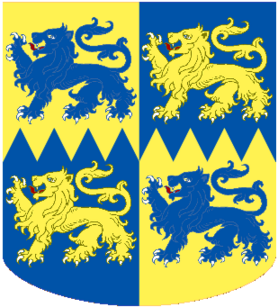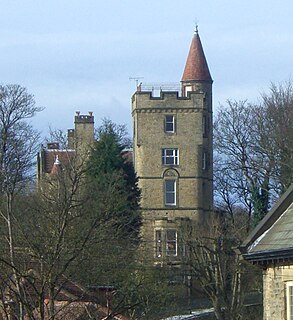
Sir Charles BarryFRS RA was a British architect, best known for his role in the rebuilding of the Palace of Westminster in London during the mid-19th century, but also responsible for numerous other buildings and gardens. He is known for his major contribution to the use of Italianate architecture in Britain, especially the use of the Palazzo as basis for the design of country houses, city mansions and public buildings. He also developed the Italian Renaissance garden style for the many gardens he designed around country houses.

Shugborough Hall is a stately home near Great Haywood, Staffordshire, England.

Ilam is a village in the Staffordshire Peak District of England, lying on the River Manifold. The population of the civil parish as taken at the 2011 census was 402.

Capernwray Hall is a former country house situated 3 miles east-northeast of Carnforth, Lancashire, England, and is currently used as a Christian Bible school and holiday centre. The house is recorded in the National Heritage List for England as a designated Grade II* listed building. It stands in grounds included in the Register of Historic Parks and Gardens at Grade II.

Cotton College was a Roman Catholic boarding school in Cotton, Staffordshire, United Kingdom. It was also known as Saint Wilfrid's College.
Samuel Wyatt was an English architect and engineer. A member of the Wyatt family, which included several notable 18th- and 19th-century English architects, his work was primarily in a neoclassical style.

St Oswald's Church is a Church of England parish church located in Ashbourne, in the county of Derbyshire, England.

Knowsley Hall is a stately home near Liverpool in the Metropolitan Borough of Knowsley, Merseyside, England. Since 1953 it has been designated a Grade II* listed building, and is the ancestral home of the Stanley family, the Earls of Derby. The hall is surrounded by 2,500 acres (10 km2) of parkland, which contains the Knowsley Safari Park. Though the hall is still owned by the Stanley family, and remains the seat of the Earldom of Derby, it is no longer a family home and instead used for functions such as corporate events, conferences and weddings.

Tatton Hall is a country house in Tatton Park near Knutsford, Cheshire, England. It is designated as a Grade I-listed building and is open to the public.

Wolterton Hall, is a large country house in the ecclesiastical parish of Wickmere with Wolterton and the civil parish of Wickmere in the English county of Norfolk, England, United Kingdom. The present hall was commissioned by the 1st Lord Walpole of Wolterton and completed in 1742, it was designed by the architect Thomas Ripley who was a protégé of Lord Walpole and his brother Sir Robert Walpole.
This is a list of the sheriffs and high sheriffs of Staffordshire.
Knypersley Hall is an 18th-century Georgian style country mansion at Biddulph, Staffordshire, England. It is protected as a Grade II* Listed building. After falling into a state of disrepair it was partially subdivided into residential apartments, although the Hall was not wholly restored at this point and was falling into further disrepair. However, the current owner has restored, repaired and divided into three separate residential dwellings - Knypersley Hall, East View and West View which complement the remainder of the original buildings which were part of the original Hall Estate.

Rivington Unitarian Chapel is an active place of Unitarian worship in Rivington, Lancashire, England. It was founded in 1703, although its congregation dates to 1667. It is designated as a Grade II* listed building with some restoration in 1990.

Spott is a small village on the eastern fringes of East Lothian in Scotland, just over 2 miles (3.2 km) south-west of Dunbar. The village straddles an unclassified road leading from the main A1 highway at grid reference NT673755.

Thomas Cromwell, 1st Earl of Ardglass was an English nobleman, son of Edward Cromwell, 3rd Baron Cromwell and second wife Frances Rugge.

Wingfield Cromwell, 2nd Earl of Ardglass, DCL, was an English nobleman, son of Thomas Cromwell, 1st Earl of Ardglass and Elizabeth Meverell. He held the subsidiary titles of 2nd Viscount Lecale and 5th Baron Cromwell of Oakham.

Barrow Bridge is a model village in the north-west outskirts of Bolton in Greater Manchester, England. It was created in the Industrial Revolution but since the demolition of the mills is now a residential village.

The Towers is a small English country house situated in Sheffield, England. The house stands on Sandygate Road close to the junction with Coldwell Lane in the suburb of Crosspool. It is a Grade II listed building as is the lodge and attached gateway and the concave garden wall. It has been described as “an extraordinary Scottish baronial fantasy”.

Ellenborough Park Hotel is a country house hotel in Southam, about 2+1⁄2 miles (4.0 km) northeast of the centre of Cheltenham, Gloucestershire, England. It is a Grade II* listed building.

Nappa Hall is a fortified manor house in Wensleydale, North Yorkshire, England, described by English Heritage as "probably the finest and least-spoilt fortified manor house in the north of England". It stands 1-mile (1.6 km) east of Askrigg, overlooking pastures leading down to the River Ure. A single-storey central hall sits between two towers, a four-storey western tower and a two-storey eastern tower. The four-storey tower has a turret, lit by slit vents, for a spiral staircase that climbs to crenellated parapets. The taller tower retains its original windows, but sash windows were inserted in the 18th century in the lower two-storey block which housed the kitchen and service rooms, at the opposite end of the hall. In the 17th century, an extra wing was added.



















